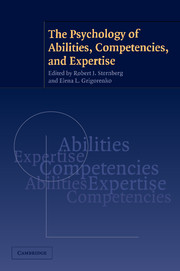Book contents
- Frontmatter
- Contents
- Preface
- List of Contributors
- The Psychology of Abilities, Competencies, and Expertise
- 1 Trait Complexes, Cognitive Investment, and Domain Knowledge
- 2 Intelligence as Adaptive Resource Development and Resource Allocation: A New Look Through the Lenses of SOC and Expertise
- 3 Developing Childhood Proclivities into Adult Competencies: The Overlooked Multiplier Effect
- 4 The Search for General Abilities and Basic Capacities: Theoretical Implications from the Modifiability and Complexity of Mechanisms Mediating Expert Performance
- 5 On Abilities and Domains
- 6 Expertise and Mental Disabilities: Bridging the Unbridgeable?
- 7 The Early Progress of Able Young Musicians
- 8 Expertise, Competence, and Creative Ability: The Perplexing Complexities
- 9 Biological Intelligence
- 10 What Causes Individual Differences in Cognitive Performance?
- Index
- References
8 - Expertise, Competence, and Creative Ability: The Perplexing Complexities
Published online by Cambridge University Press: 05 June 2012
- Frontmatter
- Contents
- Preface
- List of Contributors
- The Psychology of Abilities, Competencies, and Expertise
- 1 Trait Complexes, Cognitive Investment, and Domain Knowledge
- 2 Intelligence as Adaptive Resource Development and Resource Allocation: A New Look Through the Lenses of SOC and Expertise
- 3 Developing Childhood Proclivities into Adult Competencies: The Overlooked Multiplier Effect
- 4 The Search for General Abilities and Basic Capacities: Theoretical Implications from the Modifiability and Complexity of Mechanisms Mediating Expert Performance
- 5 On Abilities and Domains
- 6 Expertise and Mental Disabilities: Bridging the Unbridgeable?
- 7 The Early Progress of Able Young Musicians
- 8 Expertise, Competence, and Creative Ability: The Perplexing Complexities
- 9 Biological Intelligence
- 10 What Causes Individual Differences in Cognitive Performance?
- Index
- References
Summary
Albert Einstein is often considered one of the greatest creators of the 20th century. Indeed, he is frequently viewed as a prototypical example of creative genius. Yet what was the psychological basis of his creativity? In particular, consider the following three issues:
Samuel Johnson (1781, p. 5), the author of the first English dictionary, claimed that “the true Genius is a mind of large general powers, accidentally determined to some particular direction.” In other words, creativity may consist of a generalized information processing capacity that may be channeled to almost any endeavor. Does this statement hold for Einstein? Could he have become a Picasso or a Stravinsky had his childhood experiences only directed him toward art or music rather than toward science? Or did Einstein possess a more specialized ability that would not have served him well had he ventured outside of theoretical physics?
Whether Einstein's creative powers were general or specific, where did his capacity originate? Was Einstein's creativity an innate ability, as expressed by John Dryden's (1693/1885, p. 60) famous remark that “genius must be born, and never can be taught”? Or was the capacity slowly and arduously acquired through education, practice, and training? Was Einstein merely the most expert and competent theoretical physicist of his day?
[…]
- Type
- Chapter
- Information
- The Psychology of Abilities, Competencies, and Expertise , pp. 213 - 239Publisher: Cambridge University PressPrint publication year: 2003
References
- 27
- Cited by



